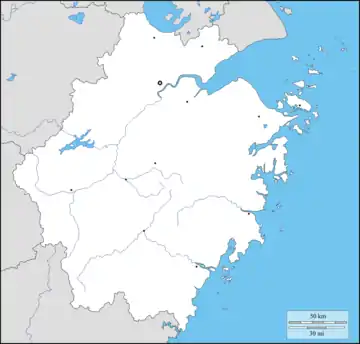Zhuji
Zhuji (simplified Chinese: 诸暨; traditional Chinese: 諸暨; pinyin: Zhūjì) is a county-level city under the administration of the prefecture-level city of Shaoxing, in north-central Zhejiang province, China, located about 40 miles (64 km) south of Hangzhou. It has 2,311 km2 (892 sq mi) with a population of 1,157,938 inhabitants at the 2010 census even though the built-up (or metro) area is much smaller. It is served by Zhuji Railway Station.
Zhuji
诸暨市 Chuki | |
|---|---|
 | |
 Zhuji Location in Zhejiang | |
| Coordinates: 29°43′N 120°14′E | |
| Country | People's Republic of China |
| Province | Zhejiang |
| Prefecture-level city | Shaoxing |
| Area | |
| • County-level city | 2,311.41 km2 (892.44 sq mi) |
| • Urban | 2,311.41 km2 (892.44 sq mi) |
| • Metro | 2,311.41 km2 (892.44 sq mi) |
| Population (2010 census) | |
| • County-level city | 1,157,938 |
| • Density | 500/km2 (1,300/sq mi) |
| • Urban | 1,157,938 |
| • Urban density | 500/km2 (1,300/sq mi) |
| • Metro | 1,157,938 |
| • Metro density | 500/km2 (1,300/sq mi) |
| Time zone | UTC+8 (China Standard) |
History
The region around Zhuji has been settled since Neolithic times and was the origin of the Wuyue culture.[1] During the Spring and Autumn period, it was the birthplace of the legendary beauty Xi Shi.[2] After the state of Yue was absorbed into the unification of China, Qin Shi Huang formally codified the boundaries of Zhuji as a county in 222 BC. This status remained intact until 1989, when the State Council reclassified Zhuji as a city.
Administrative divisions
Subdistricts:[3]
- Jiyang Subdistrict (暨阳街道), Huandong Subdistrict (浣东街道), Taozhu Subdistrict (陶朱街道)
Towns:
- Datang (大唐镇), Ciwu (次坞镇), Diankou (店口镇), Ruanshi (阮市镇), Jiangzao (江藻镇), Fengqiao (枫桥镇), Zhaojia (赵家镇), Majian (马剑镇), Caota (草塔镇), Paitou (牌头镇), Tongshan (同山镇), Anhua (安华镇), Jieting (街亭镇), Huangshan (璜山镇), Lipu (浬浦镇), Zhibu (直埠镇), Wuxie (五泄镇), Lingbei (岭北镇), Chenzhai (陈宅镇), Wangjiajing (王家井镇), Yingdianjie (应店街镇), Shanxiahu (山下湖镇), Dongbaihu (东白湖镇)
The only township is Donghe Township (东和乡)
Economy
Zhuji is located in the Yangtze River Delta Economic Zone. Although there is not much arable land per capita, relying on the rich water resources of the Puyang River, it has developed agriculture well since ancient time. During the period of the Republic of China, many people in Zhuji, like other Zhejiang people in the surrounding areas, left their hometowns to develop in Shanghai, and operated small workshops, small factories, and textile and nanny jobs. After the reform and opening up, we vigorously developed townships, home-based industries, and made considerable achievements in textile and hardware manufacturing. At the same time, the two natural and cultural hotspots of Xi Shi and Wu Xie are used to develop the tourism industry. Its modern civic strengths include an excellent educational system and robust economic development, especially in the production of pearls, socks and embroidery machinery Datang.[4] Due to its pearl production, the city has become known as "The Pearl City". Apart from Pearl, it also has many other local specialties: The textile industry is well developed. It has the largest hosiery industry in the country. Small hardware industry. Spring, small and medium-sized bearings. Rich in freshwater pearls, it has the largest pearl trading market in China and is known as the hometown of pearls. Citron is also a local specialty. tea.
Gallery
 Purification Festival at the Orchid Pavilion, depicting a famed gathering at Wang Xizhi's estate in Zhuji, Zhejiang Province
Purification Festival at the Orchid Pavilion, depicting a famed gathering at Wang Xizhi's estate in Zhuji, Zhejiang Province
References
- China Archaeology & Art Digest. Art Text (HK) Pty Limited. 1999. p. 178.
- Lee (2007). Biographical Dictionary of Chinese Women: Antiquity Through Sui, 1600 B.C.E.-618 C.E. M.E. Sharpe. p. 85. ISBN 978-0-7656-4182-3.
- "绍兴市-行政区划网 www.xzqh.org" (in Chinese). XZQH. Retrieved 2012-05-24.
- Bloom, Stephen G. (10 May 2011). Tears of Mermaids: The Secret Story of Pearls. St. Martin's Press. p. 109. ISBN 978-1-4299-2363-7.
External links
| Wikimedia Commons has media related to Zhuji. |
